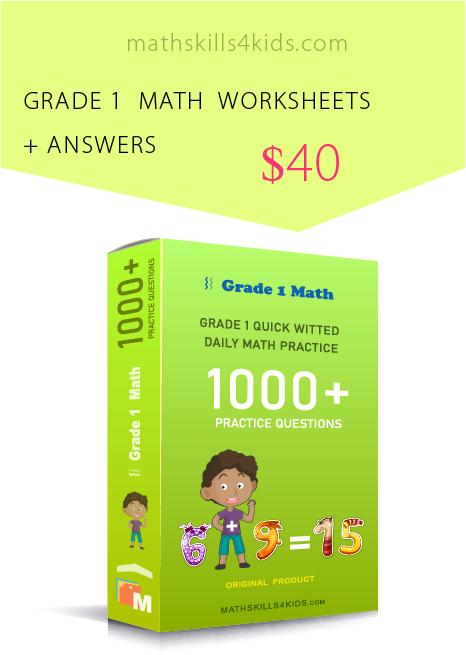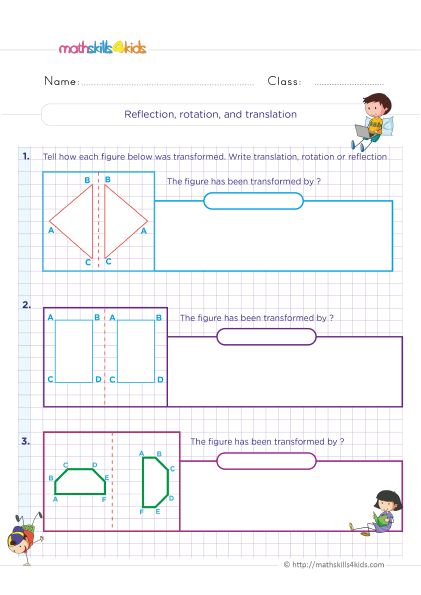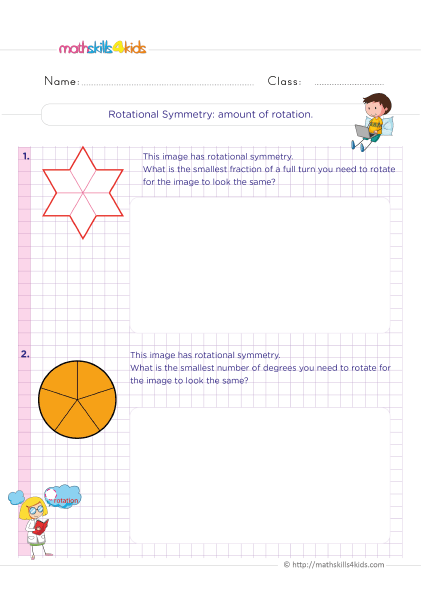From lines to reflections: Exploring symmetry in 4th Grade worksheets
-
Are you ready to dive into the captivating world of symmetry? Quickly access this article and have fun exploring symmetry in 4th Grade worksheets with your students. From lines to reflections, symmetry is all around us, and understanding it can open up a whole new way of looking at the world.
So, join us in this article; let’s embark on an exciting adventure into symmetry!
Boost your child's symmetry skills with these 4th-Grade worksheets
In 4th grade, students begin to explore the concept of symmetry, a fundamental aspect of mathematics and art. However, to boost your child's symmetry skills, you can download and use Mathskills4kids’ 4th-Grade worksheets designed with fun, familiar symmetrical patterns, and educational tools.
This article will explore how these educational tools can help students develop their spatial awareness, critical thinking skills, and creativity. We will also delve into various types of symmetry, including line, rotational, and bilateral symmetry, and provide practical examples and exercises to reinforce learning.
-
BROWSE THE WEBSITE
-
DOWNLOAD FREE WORKSHEETS
-
-
4th GRADE MATH TOPICS
- Number sense
- Addition
- Subtraction
- Multiplication
- Division
- Mixed operations
- Variable expressions
- Functions
- Coordinate plane
- Data and graphs
- Logical reasoning
- Patterns and sequences
- Money math
- Units measurement
- Telling time
- Equivalent fractions
- Compare & order fractions
- Add & subtract fractions with like denominators
- Add & subtract fractions with unlike denominators
- Multiply fractions
- Decimals
- Add and subtract decimals
- Probabilities and statistics
- 2D shapes
- Triangles and quadrilaterals
- Symmetry
- Angles
- 3D shapes
- Geometric measurement
-
Buying is supporting us!
Buy Now...
-
-
What is symmetry, and why is it important?
Before exploring symmetry in 4th Grade worksheets, let’s find out what symmetry is and why it is important.
Symmetry is a concept that refers to a balanced arrangement of elements where one part mirrors another. It can be found in nature, architecture, art, and everyday objects. Understanding symmetry is crucial as it helps develop spatial awareness, critical thinking, and problem-solving skills.
Also, symmetry plays a significant role in various fields, including mathematics, science, and design. Introducing symmetry to 4th-grade students lays the foundation for a deeper understanding of these concepts in the future.
Symmetry can be broadly classified into different types, each with its characteristics and applications. The two most common types of symmetry are line symmetry and rotational symmetry.
Let's explore these types in more detail.
-
Types of symmetry - line symmetry and rotational symmetry
Line symmetry
Line symmetry, or reflection symmetry, occurs when an object or shape can be divided into two equal parts, with one part being a mirror image of the other. The line along which the object can be divided is known as the line of symmetry.
For example, think of a butterfly with its wings spread open. If we draw a line down the center of the butterfly, the two sides will be mirror images of each other. Line symmetry can be vertical, horizontal, or diagonal, depending on the orientation of the line of symmetry.
Rotational symmetry
Rotational symmetry refers to an object or shape that can be rotated around a point and maintain its original appearance. In other words, it looks the same at various angles of rotation. A common example is a star, where each point of the star is equidistant from the center and can be connected to form lines of symmetry. Rotational symmetry is often found in geometric shapes and figures like circles, regular polygons, and spirals.
Understanding these types of symmetry is essential as they provide a framework for exploring and analyzing the world around us. Now, let's dive deeper into how line and rotational symmetry can be effectively taught using 4th-grade worksheets.
-
Teaching line symmetry through worksheets
Line symmetry is an excellent starting point for introducing 4th-grade students to symmetry. Worksheets can be an engaging and interactive way to teach line symmetry, allowing students to practice identifying and drawing lines of symmetry. Here are a few key strategies for teaching line symmetry through worksheets:
- Visual examples: Begin by showing students visual examples of objects with line symmetry, such as letters of the alphabet, shapes, or even real-life objects. Discuss the presence of a line of symmetry and encourage students to identify the mirror image on either side.
- Collaborative exercises: Provide worksheets with partially completed symmetrical shapes and ask students to complete the missing parts. This collaborative approach fosters teamwork and allows students to learn from one another.
- Reflection activities: Incorporate reflection activities where students draw lines of symmetry on various objects or shapes. For instance, you can provide worksheets with irregular shapes and ask students to draw lines of symmetry to divide the shape into two equal parts.
By incorporating these strategies into worksheets, students can actively engage with line symmetry and develop a strong understanding of this concept.
-
Exploring reflection symmetry in 4th-grade worksheets
Reflection symmetry, also known as bilateral symmetry, is another important aspect of symmetry that can be explored through 4th-grade worksheets. Unlike line symmetry, which involves a single line of symmetry, reflection symmetry involves multiple symmetrical lines. Here are some approaches to teaching reflection symmetry using worksheets:
- Mirror image drawing: Provide worksheets with incomplete shapes and ask students to draw the mirror image to complete the shape. This activity helps students understand how reflection symmetry works and strengthens their ability to identify symmetrical elements.
- Symmetrical patterns: Introduce worksheets with symmetrical patterns and ask students to identify the lines of symmetry within the pattern. This exercise enhances visual perception and pattern recognition skills while reinforcing the concept of reflection symmetry.
- Real-life examples: Incorporate worksheets that showcase real-life examples of reflection symmetry, such as buildings, animals, or natural objects. Encourage students to identify the lines of symmetry and discuss why symmetry is prevalent in these examples.
By providing opportunities to explore reflection symmetry through 4th-grade worksheets, students can develop a deeper appreciation for symmetry in the world around them.
-
Hands-on activities for understanding symmetry
While worksheets effectively teach symmetry, incorporating hands-on activities can further enhance students' understanding and engagement. Here are some exciting and interactive activities to supplement Mathskills4kids’ symmetry worksheets:
- Symmetry art: Allow students to create symmetrical artwork using various materials, such as paints, colored pencils, or construction paper. Please encourage them to experiment with different shapes, patterns, and colors to create visually appealing symmetrical compositions.
- Symmetry scavenger hunt: Organize a classroom or outdoor scavenger hunt where students search for objects or shapes with line or reflection symmetry. Provide worksheets to record their findings and discuss their observations as a group.
- Mirror play: Provide small handheld mirrors to students and ask them to explore their reflections and identify symmetry lines on their faces or body. This activity promotes self-awareness and connects the concept of symmetry to personal experiences.
By incorporating hands-on activities, students can actively apply their knowledge of symmetry and experience its relevance in real-world contexts.
-
Incorporating symmetry into other subjects
Symmetry is not limited to the realm of mathematics alone. It can be seamlessly integrated into other subjects, enriching students' learning experiences across the curriculum. Here are a few examples of how symmetry can be incorporated into different subjects:
- Art: Explore the works of famous artists known for using symmetry, such as Leonardo da Vinci or M.C. Escher. Discuss how these artists incorporated symmetry into their artwork and encourage students to create their symmetrical masterpieces.
- Science: Discuss the role of symmetry in nature, particularly in biology and botany. Explore examples of symmetrical organisms, such as butterflies, flowers, or crystals, and discuss how their symmetry contributes to their functionality and aesthetics.
- Language arts: Introduce poetry or literature incorporating symmetrical patterns, such as palindromes or acrostic poems. Analyze the structure and meaning behind these literary devices, fostering creativity and critical thinking skills.
Students can develop a holistic understanding of this concept and its applications beyond mathematics by integrating symmetry into various subjects.
-
Common challenges in teaching symmetry and how to overcome them
Teaching symmetry may come with its own set of challenges. Some students may struggle with visual perception, while others may find it challenging to identify lines of symmetry accurately. Here are some common challenges in teaching symmetry and strategies to overcome them:
- Visual aids: Use visual aids, such as diagrams, charts, or interactive software, to help students visualize and understand the concept of symmetry. These aids provide a concrete representation of abstract ideas, making it easier for students to grasp the concept.
- Progressive difficulty: Begin with simple symmetrical shapes and gradually increase the complexity. This approach allows students to build confidence and develop their skills step-by-step.
- Individualized support: Provide one-on-one or small group sessions for students requiring additional assistance. This personalized attention can help address specific challenges and reinforce learning.
- Real-world connections: Emphasize the relevance of symmetry in everyday life and various fields of study. Students can develop a deeper appreciation for the subject by highlighting the practical applications of symmetry.
By addressing these challenges proactively, teachers can create a supportive learning environment that enables students to overcome obstacles and succeed in their understanding of symmetry.
Bonus: Resources for symmetry worksheets and lesson plans
Various resources, worksheets, and lesson plans are available to help educators and parents incorporate symmetry into their teaching. Here are some online platforms and websites that offer free or paid resources for teaching symmetry:
- Online Math Learning.com: This website offers Videos, examples, solutions, and lessons to help Grade 4 students learn to recognize a line of symmetry for a two-dimensional figure as a line across the figure. https://www.onlinemathlearning.com/line-symmetry-4g3.html.
- National Council of Teachers of Mathematics (NCTM): The NCTM website offers a range of symmetry-related lesson plans and activities for different grade levels. These resources align with national standards and provide guidance for effective implementation. https://www.nctm.org/standards/.
- com: This educational math website offers a variety of activities and worksheets that will help students reflect on lines of symmetry. Also, this resource for lines of symmetry builds on students’ interest in drawing while teaching the fundamental aspects of the geometrical concept. https://www.education.com/resources/lines-of-symmetry/.
By utilizing these resources, teachers and parents can access a wealth of materials to support students' learning and exploration of symmetry.
-
-
Thank you for sharing the links of MathSkills4Kids.com with your loved ones. Your choice is greatly appreciated.
Conclusion
Symmetry is a fascinating concept that can captivate the minds of 4th-grade students. By exploring symmetry in Grade 4 worksheets, hands-on activities, and cross-curricular integration, educators can help students develop spatial awareness, critical thinking skills, and creativity.
Understanding symmetry is not just limited to mathematics; it extends to various fields of study and enriches students' overall educational experience. So, let's embrace the world of symmetry and empower the next generation of learners to see the beauty and balance that surrounds us!






